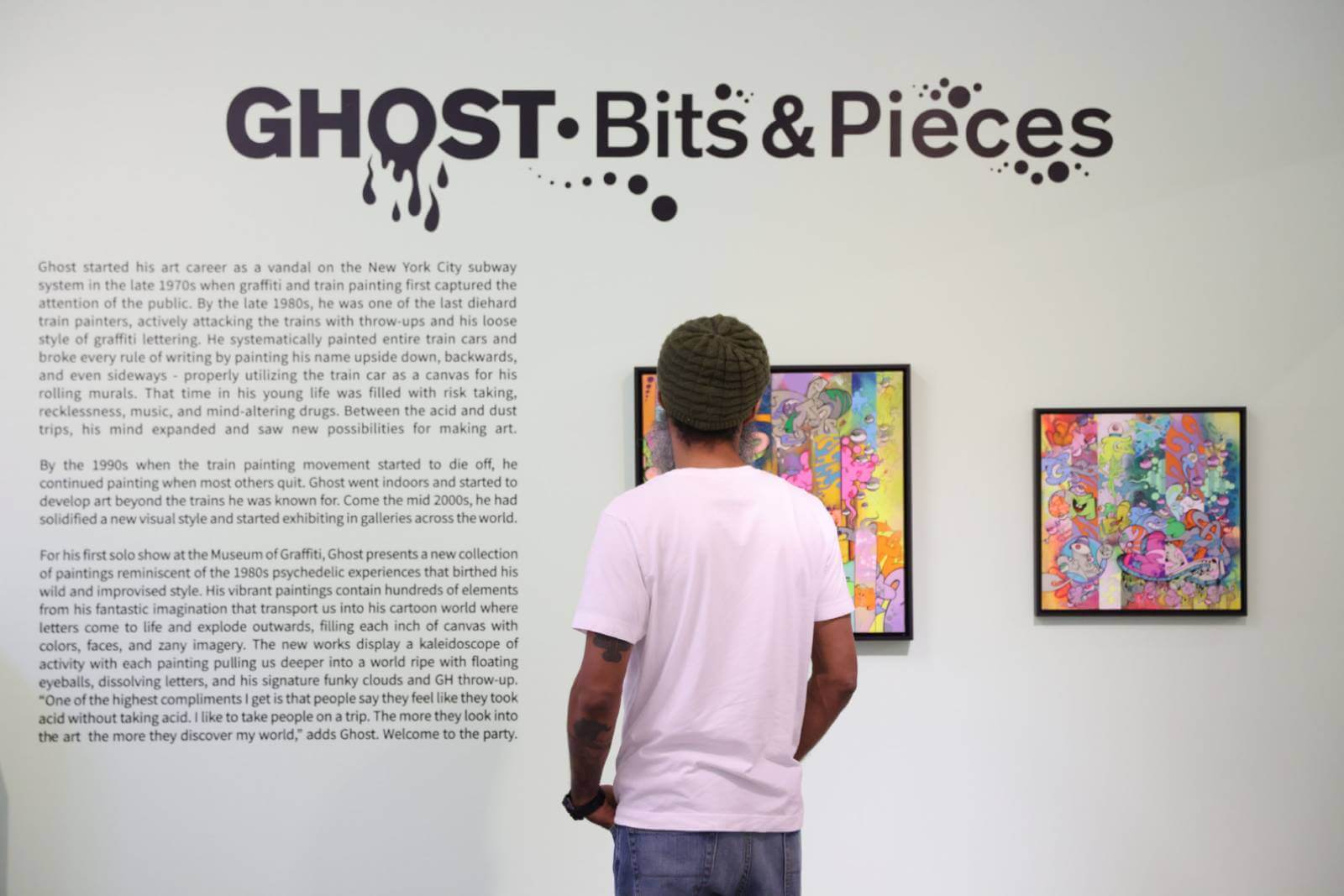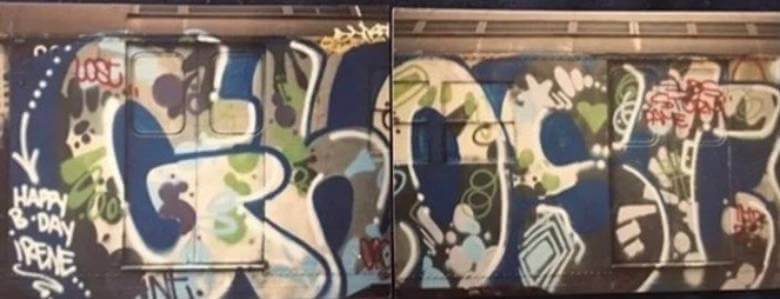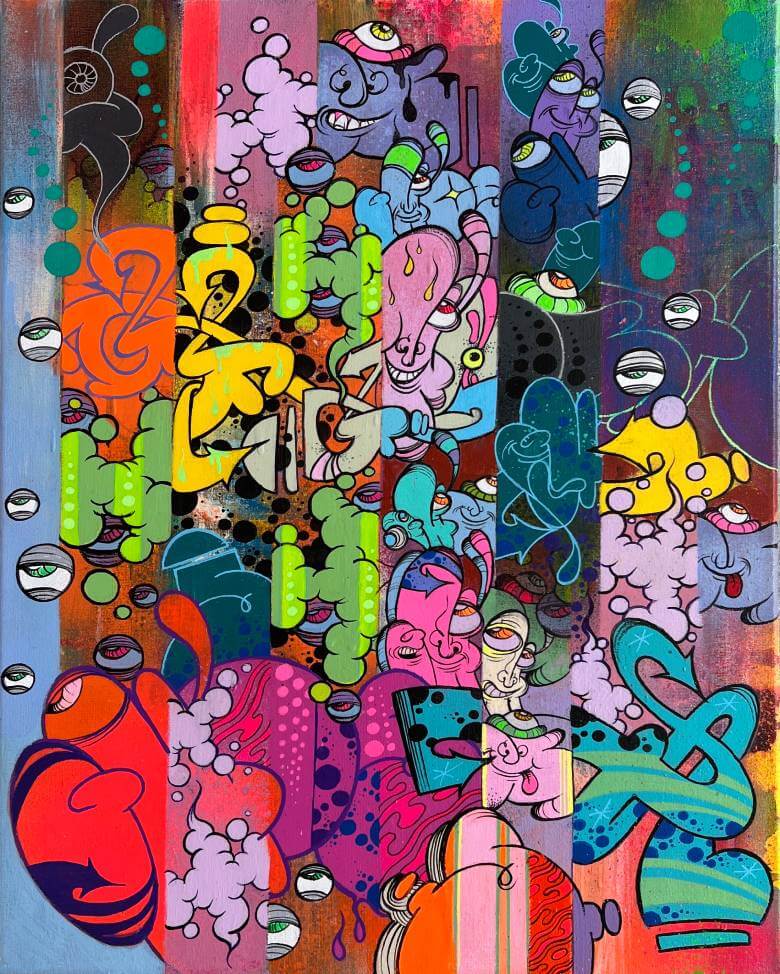
Ghost RIS is a true outlier in the world of graffiti. His journey started in the 1970s in New York, he was one of the few active train writers in the city by the mid 1990s. Combining loose, psychedelic pieces with a military approach to bombing with his trademark “dust-fill” throw-ups, his work caught the eye of a nascent graffiti scene in Europe, which has welcomed him since the turn of the century.
“Bits and Pieces” is his first solo exhibition which opened this month at the Museum of Graffiti in Miami, featuring an all-new selection of canvases and a limited edition print, “Everyone’s Got Their Own Arrow.”
MTN World got the chance to talk to Ghost a few days after the opening.
MTN World: The show takes place at the Museum of Graffiti, curated by your crewmate Alan Ket. How can a friend help to better present your work?
Ghost: Ket knows how to communicate to people outside of the culture and present work. He basically does things that most writers, including myself, don’t know how to do.

MTN: Why is it important for you personally to connect with the public in Miami?
G: It’s not about me, it’s about presenting my work. I want people to see the work.
MTN: Almost all writers who have ended up showing work have revealed their name and/or face. How important is it for you to maintain your true identity? Has it been a challenge in the era of camera phones and social media?
G: It’s a challenge. Everywhere you turn there are cameras staring. I don’t think it’s important for me to be known. It’s all about the name. Once again, just in case I do decide to write again I want to be able to have that anonymity so that I don’t get arrested. It’s hard to talk your way out of it if people know who you are. I like the idea of laying back in the cut. I don’t have to be the center of attention. It’s not important.

MTN: We’ve been fascinated by your work since we first laid eyes on it. Were you aware that you were breaking boundaries and conventions when you were painting your first trains?
G: I didn’t think I was breaking boundaries, but writing is always about trying to outdo your opponents. When I started to do pieces upside, backwards and sideways I guess I was just trying to do something different so that my name stood out and apart from the others. That was important.
MTN: What’s your own personal favourite piece you’ve ever done? Is it memorable because of the experience, context or end result?
G: The Ghost piece with the RIS dripping off the top of the train. I liked the way it came out, it was big and bold. For the most part I never really liked what I did. It was just about getting up and getting it done.
MTN: RIS is more well known for bombing than elaborate pieces. Do you consider throw-ups and tags art too?
G: Could be. When I do it, I make it look good. Some writers do it well and it’s really about the way we use them.

MTN: You’ve had a lot of contact with the European graffiti scene over the years. How important has the European graffiti scene been on your development as an artist? What have you learnt from your trips over here?
G: Not much that I know of as far as writing or style. I went out there with my way of thinking and doing things.

MTN: New York old school styles like the one you’re associated with seem to have had more influence in Europe than in United States. How could you explain this phenomenon?
G: There are only certain writers in Europe really incorporating 80s style graffiti from New York. I think the biggest influencers in Europe were probably Wane, Reas, Sento, and Poem. You can’t really generalize it because different places have been influenced by their own writers. I see the 70s influences but I don’t see more than that.

MTN: In what we call “graffiti art,” we find art done by some graffiti writers that doesn’t have a stylistic relationship within what they write. In your case, as in the case of many other graffiti artists, there is. How does your studio work relate to your graffiti?
G: My foundation is that I am a writer. It’s still about letters and my name. It’s about trying to use and manipulate the letters to make it attractive to people that are non-writers. I abstract it a bit so that you are not looking at a regular piece but a combination of pieces that makes my work more relatable to everyone.

“Ghost: Bits and Pieces” opens Thursday, May 19 2022, at the Museum of Graffiti, 276 NW 26th St., Miami. Get your tickets from museumofgraffiti.com.
Check out an interview from Alan Kets and Musa71 with Lady Pink who also showed at the Museum of Graffiti here.


Ghost RIS is a true outlier in the world of graffiti. His journey started in the 1970s in New York, he was one of the few active train writers in the city by the mid 1990s. Combining loose, psychedelic pieces with a military approach to bombing with his trademark “dust-fill” throw-ups, his work caught the eye of a nascent graffiti scene in Europe, which has welcomed him since the turn of the century.
“Bits and Pieces” is his first solo exhibition which opened this month at the Museum of Graffiti in Miami, featuring an all-new selection of canvases and a limited edition print, “Everyone’s Got Their Own Arrow.”
MTN World got the chance to talk to Ghost a few days after the opening.
MTN World: The show takes place at the Museum of Graffiti, curated by your crewmate Alan Ket. How can a friend help to better present your work?
Ghost: Ket knows how to communicate to people outside of the culture and present work. He basically does things that most writers, including myself, don’t know how to do.

MTN: Why is it important for you personally to connect with the public in Miami?
G: It’s not about me, it’s about presenting my work. I want people to see the work.
MTN: Almost all writers who have ended up showing work have revealed their name and/or face. How important is it for you to maintain your true identity? Has it been a challenge in the era of camera phones and social media?
G: It’s a challenge. Everywhere you turn there are cameras staring. I don’t think it’s important for me to be known. It’s all about the name. Once again, just in case I do decide to write again I want to be able to have that anonymity so that I don’t get arrested. It’s hard to talk your way out of it if people know who you are. I like the idea of laying back in the cut. I don’t have to be the center of attention. It’s not important.

MTN: We’ve been fascinated by your work since we first laid eyes on it. Were you aware that you were breaking boundaries and conventions when you were painting your first trains?
G: I didn’t think I was breaking boundaries, but writing is always about trying to outdo your opponents. When I started to do pieces upside, backwards and sideways I guess I was just trying to do something different so that my name stood out and apart from the others. That was important.
MTN: What’s your own personal favourite piece you’ve ever done? Is it memorable because of the experience, context or end result?
G: The Ghost piece with the RIS dripping off the top of the train. I liked the way it came out, it was big and bold. For the most part I never really liked what I did. It was just about getting up and getting it done.
MTN: RIS is more well known for bombing than elaborate pieces. Do you consider throw-ups and tags art too?
G: Could be. When I do it, I make it look good. Some writers do it well and it’s really about the way we use them.

MTN: You’ve had a lot of contact with the European graffiti scene over the years. How important has the European graffiti scene been on your development as an artist? What have you learnt from your trips over here?
G: Not much that I know of as far as writing or style. I went out there with my way of thinking and doing things.

MTN: New York old school styles like the one you’re associated with seem to have had more influence in Europe than in United States. How could you explain this phenomenon?
G: There are only certain writers in Europe really incorporating 80s style graffiti from New York. I think the biggest influencers in Europe were probably Wane, Reas, Sento, and Poem. You can’t really generalize it because different places have been influenced by their own writers. I see the 70s influences but I don’t see more than that.

MTN: In what we call “graffiti art,” we find art done by some graffiti writers that doesn’t have a stylistic relationship within what they write. In your case, as in the case of many other graffiti artists, there is. How does your studio work relate to your graffiti?
G: My foundation is that I am a writer. It’s still about letters and my name. It’s about trying to use and manipulate the letters to make it attractive to people that are non-writers. I abstract it a bit so that you are not looking at a regular piece but a combination of pieces that makes my work more relatable to everyone.

“Ghost: Bits and Pieces” opens Thursday, May 19 2022, at the Museum of Graffiti, 276 NW 26th St., Miami. Get your tickets from museumofgraffiti.com.
Check out an interview from Alan Kets and Musa71 with Lady Pink who also showed at the Museum of Graffiti here.

2 What do you think?
Add a comment